Key Insights
- NEAR has raised over $1 billion to accelerate development of the NEAR protocol ecosystem.
- During Q3, NEAR set an all-time-high of 3 million active accounts. The increase was primarily due to the launch of the move-to-earn protocol Sweat Economy.
- NEAR ended Q3 with 96 million NEAR TVL ($343 million), up 10X from the start of 2022.
- Phase 1 of Nightshade went live on mainnet enabling full (data + processing) sharding for a new subset of NEAR validators, chunk-only producers. The update improved decentralization by lowering hardware requirements and tripling the network’s validator capacity.
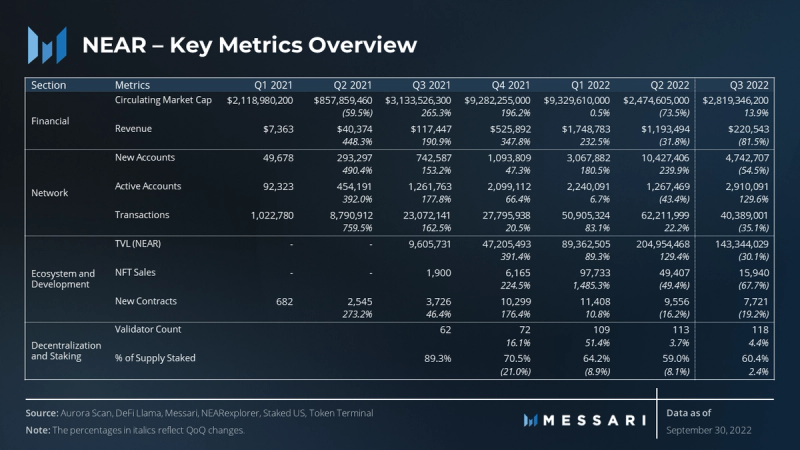
A Primer on NEAR
NEAR Protocol is a smart contract platform that utilizes a Thresholded Proof of Stake (PoS) consensus algorithm to execute transactions. NEAR incorporates a Nightshade Sharding mechanism, which facilitates increased transaction throughput and the scalability of the network. Additionally, NEAR has raised over $1 billion for ecosystem development, takes a novel approach to basic network functionality (such as accounts, gas, and transactions), prioritizes developer friendliness, and supports EVM and Substrate via Aurora and Octopus Network.
Performance Analysis
Financial Overview

Following a second quarter, which saw NEAR lose 74% of value by market cap, NEAR market cap rebounded in the third quarter with a 14% QoQ increase from $2.47 billion to $2.82 billion. NEAR remains 70% off of its all-time-high of $9.6 billion on Dec. 27, 2021.
Revenue declined 82% QoQ to $220,000. The decrease in revenue was driven by a 35% drop in transactions paired with sub-one-cent transition fees. For comparison, Polygon had $4.2 million in quarterly revenue (-26% QoQ) with a $0.09 transaction fee and Avalanche had $2.3 million in quarterly revenue (-94% QoQ) with a $0.14 average transaction fee.
NEAR is the native token of the NEAR protocol. Near is used for securing the network via staking, transaction fees, and storage fees. Unlike Ethereum’s auction-style mechanism, NEAR transaction fees adjust according to network compute and bandwidth. Storage fees, thought of as long-term costs for resources, are payments made by accounts and smart contracts for using storage space on the NEAR network.
NEAR does not have a fixed supply and uses both inflationary and deflationary mechanisms. There is a yearly fixed inflation rate of 5%, of which 90% is awarded to validators with the remaining 10% going to the protocol treasury. The NEAR treasury is controlled by the NEAR Foundation. At the end of Q3, the treasury had a balance of 10 million NEAR ($36 million). Of the total transaction fees, 70% are burned and the remaining 30% goes to the contract that the transaction came from. Depending on the number of transactions and the value of gas volume, NEAR has the potential to be deflationary. NEAR ended Q3 with approximately 800 million NEAR in circulation and continues to follow a five-year distribution schedule.
Network Overview

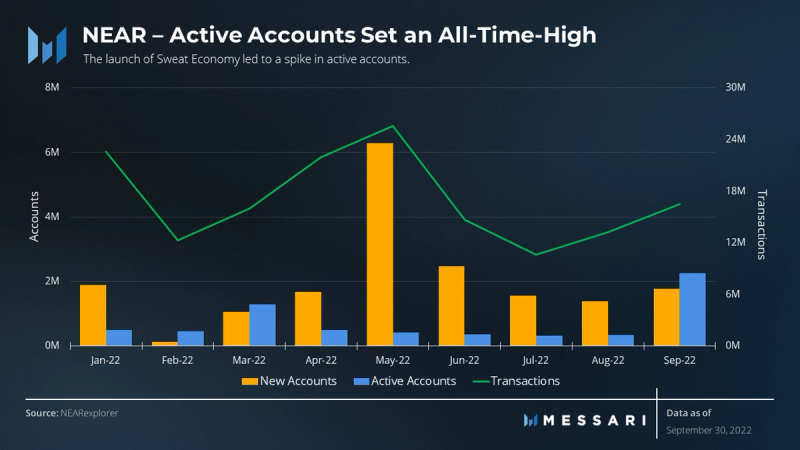
During Q3, NEAR network activity yielded mixed results. Active addresses spiked 130% QoQ to set an all-time-high of 3 million. The spike in active addresses was primarily due to the launch of Sweat Economy . Concurrently, new addresses decreased 55% QoQ to 4.7 million and transactions decreased 35% QoQ to 40 million.
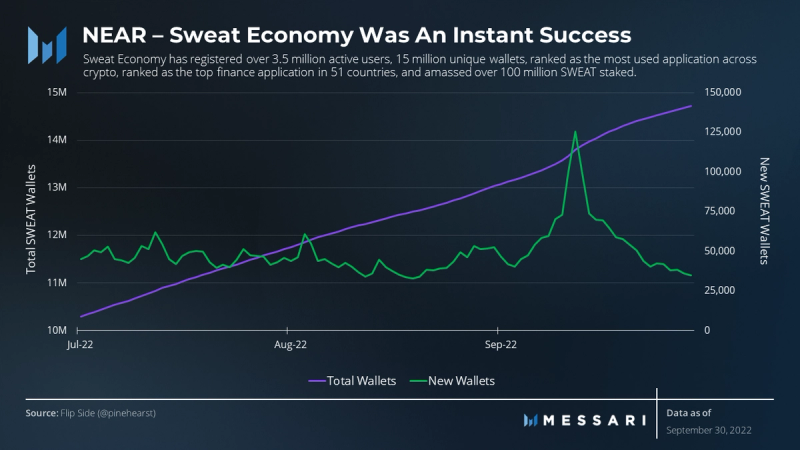
In April, a new partnership with Sweatcoin was announced. The London-based technology company incentivizes people to move more via token for steps. Sweatcoin was ahead of its time using a Web2 reward system where users could accumulate tokens for movement and redeem them for rewards. Naturally, Sweatcoin made the jump to Web3.
In late July, Sweatcoin launched on NEAR as Sweat Economy. It has registered over 3.5 million active users since launch, 15 million unique wallets, ranked as the most used application across crypto, ranked as the top finance application in 51 countries, and amassed over 100 million SWEAT staked.
Ecosystem and Development
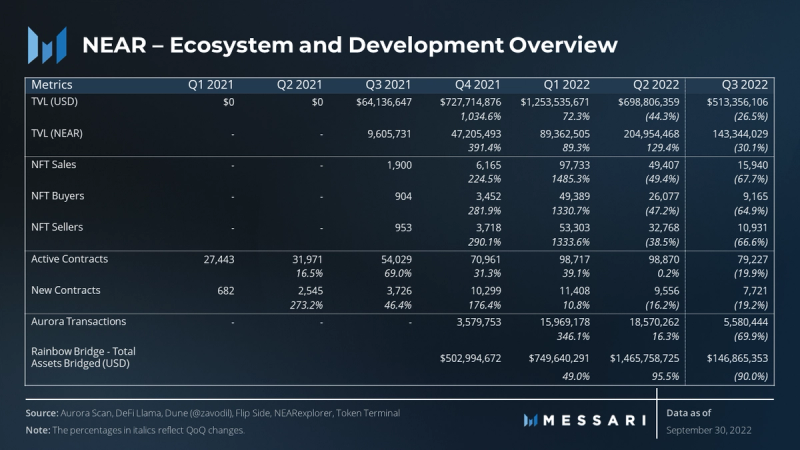
DeFi
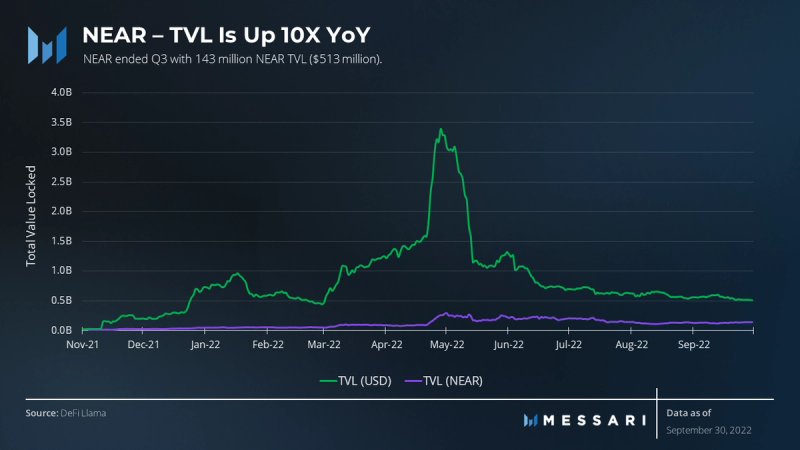

NEAR ended the third quarter with 143 million NEAR TVL ($513 million), up 10X YoY but down 30% QoQ. Ref Finance, a DEX, accounts for 45% of the TVL ($232 million). Ref Finance has been a leading application for most of NEAR’s existence and boasts blue chip investors including Alameda, Dragonfly, and Jump. Aurora, a general purpose EVM, accounts for 33% of the TVL ($170 million). Aurora is a unique component of the NEAR ecosystem, which will be covered in-depth later in this report. Burrow, a lending protocol, accounts for 10% of TVL ($52 million). Burrow launched in early Q2 and immediately spiked to over $400 million in TVL before dropping to $52 million by the close of Q3. For comparison, Avalanche ended Q3 with $1.9 billion TVL (-28% QoQ), Binance $6.6 billion (+11% QoQ), and Solana $2.1 billion (-16% QoQ).

During Q3, NEAR registered 16,000 NFT sales (-68% QoQ) and 20,000 active wallets (-66% QoQ) with an even split between NFT buyers and NFT sellers. NFT activity is dominated by Paras Marketplace, an NFT marketplace for digital cards. In early 2022, Paras released Paras Comic, a marketplace for artists to publish comic related NFTs, resulting in the February spike. Additionally, there are multiple NFT projects across a variety of use-cases that either recently launched or are in-development, including Mintbase, DAO Records, Raiz, Naksh, NEARxPublish, and Endemic.
Gaming
NEAR has a nascent gaming ecosystem. However, multiple companies are developing games or services for gaming communities and blockchain developers including:
- ARterra Labs – A Web3 fan engagement infrastructure platform for the eSports and the gaming market.
- Atlantis World – A base-layer for the metaverse connecting features including audio, video, and text and offering developer friendly features such as no-code tooling to build in the metaverse.
- OP GAMES – A blockchain gaming development company making it easy for Web2 gaming developers to migrate to Web3 using an SDK. OP offers the Arcadia Platform, a community owned Web3 gaming arcade platform for developers to launch their games. Arcadia has over 40 games.
- Vorto Gaming – A blockchain gaming development company with an NFT marketplace. The first title launched on Vorto is Hash Rush, a massive multiplayer online (MMO) strategy game using play-to-earn mechanics.
- Play Ember – A Web3 gaming platform offering an on-ramp for mobile game users and studios using NEAR wallet.
Developer Activity
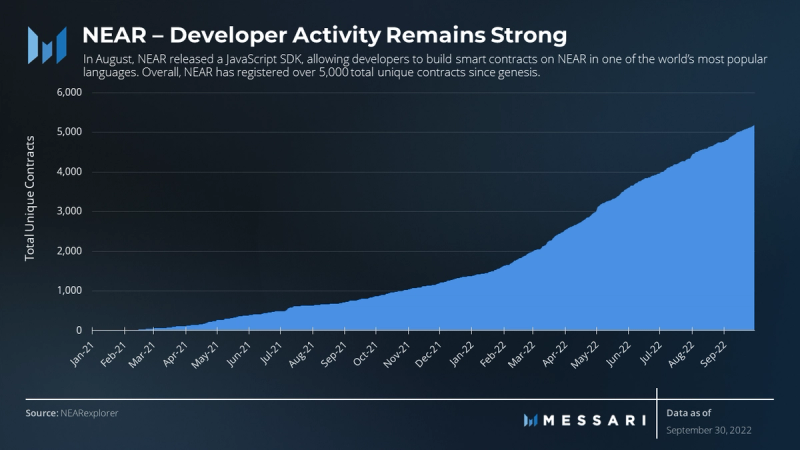
NEAR prioritizes being a developer-friendly blockchain, and a blockchain’s smart contract programming languages plays a large role in its ability to attract application developers. Previously, developers on NEAR were able to use Rust, AssemblyScript, and Solidity (through Aurora). In August, NEAR released a JavaScript SDK, allowing developers to build smart contracts on NEAR in one of the world’s most popular languages. Overall, NEAR has registered over 5,000 total unique contracts since genesis.
Aurora
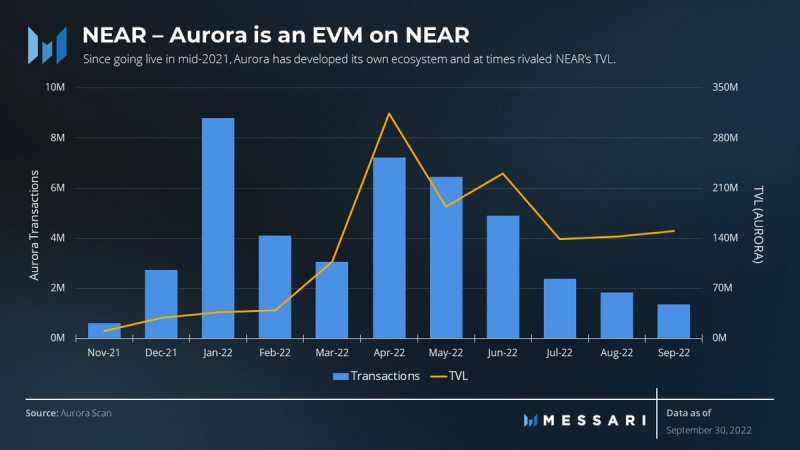
Aurora is an EVM implemented as a smart contract on NEAR. It combines the user and developer familiarity of the EVM with NEAR’s scalability and security. Former NEAR Protocol team members created Aurora, and the EVM went live in mid-2021. Since then, it has been one of the top applications on NEAR and its own ecosystem has even rivaled NEAR’s in TVL ($165 million at the end of Q3).
Aurora’s biggest update this year was the introduction of Aurora+ in Q2’22. Aurora+ is a membership program that offers various benefits, most notably 50 free transactions per month. In early September, Aurora released an upgrade that included a new cross contract call feature. The feature connects Aurora’s synchronous and NEAR’s asynchronous runtimes, allowing Aurora smart contracts to communicate with any other smart contracts on NEAR within a single transaction and without any bridging. This further connects the two ecosystems, opening up new possibilities for Aurora applications such as a DEX aggregator that can tap into liquidity on both Aurora and NEAR. Cross contract calls are currently only live on testnet, with plans to deploy on mainnet soon.
Octopus Network
Octopus Network is a network of Substrate-based, EVM-compatible application-specific blockchains (app-chains) that, like Aurora, are built as a set of smart contracts on NEAR. As with Polkadot, app-chains must register and pass a vote by holders of Octopus’s native token, OCT, before joining the network. There are currently five app-chains on mainnet.
Rainbow Bridge
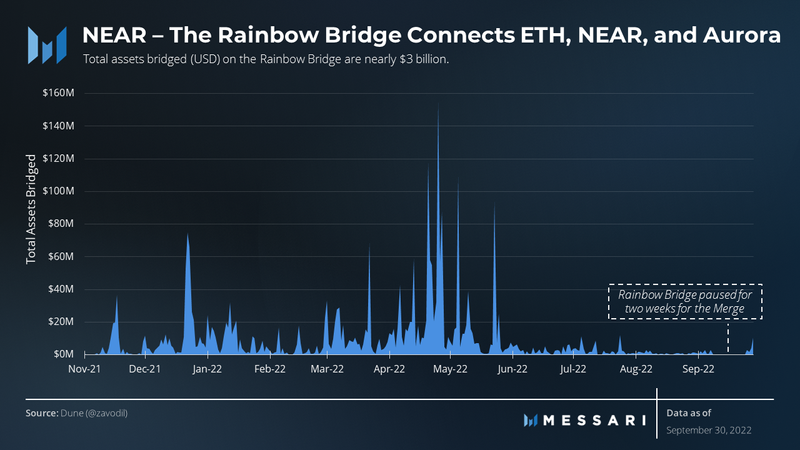
The Rainbow Bridge is a generic, permissionless, and trustless bridge connecting Ethereum, NEAR, and Aurora. The bridge is a light client based bridge that, when going to Ethereum, uses an optimistic design to be more gas-efficient. The optimistic design relies on third-party watchdogs to submit fraud proofs to challenge any false information relayed to the bridge’s light clients.
The bridge’s architecture has been successfully battle tested twice this year, first in May and more recently in August. In both cases, an attacker sent false information to the NEAR light client on Ethereum. Automatic watchdog scripts spotted the malicious transaction and submitted fraud proofs, stopping the attack. In the case of the August test, the watchdog scripts caught it within 31 seconds. Not only were no bridge funds impacted, but the attackers lost their 2.5 and 5 ETH deposits, respectively, required to become a relayer.
Total assets bridged through the Rainbow Bridge are nearly $3 billion. During Q3, assets bridged decline 90% from $1.5 billion to $145,000. The decline was exacerbated by the bridge pausing operations for approximately two weeks in anticipation of The Merge.
Decentralization and Staking
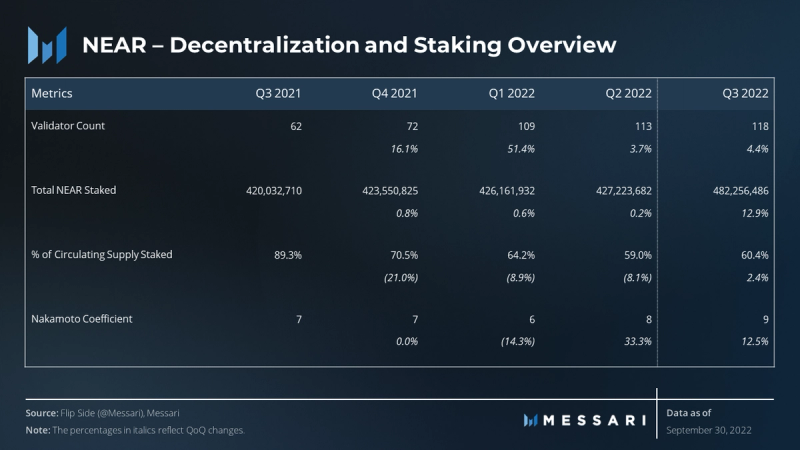
NEAR uses aThresholded Proof of Stake (PoS) consensus algorithm to execute transactions. The network algorithmically sets a minimum validator participation threshold where validators bid for participation. There are three validator roles:
- Block producers who have a maximum of 100 and validate transactions on all shards.
- Chunk-only producers who have a current maximum of 300 and validate transactions on one shard.
- Hidden validators who act as third-party actors watching for illicit activity (note: hidden validators are not live yet).
Overall, NEAR ended Q3 with 483 million NEAR staked (+13% QoQ), equaling 60% of the circulating supply staked. NEAR had 118 validators with a Nakamoto Coefficient of nine. NEAR has increased the number of active validators every quarter, suggesting that the network is gradually decentralizing. The Nakamoto Coefficient of nine puts NEAR in-line with the industry average.
Qualitative Analysis
Nightsharding
NEAR is built around horizontal scaling with its unique sharding design called Nightshade, which is being implemented in four phases. Beginning with Phase 0, which launched in Q4’21, it split the network into four data shards. Validators were required to store the state only of their assigned shard but still had to validate (process and execute) transactions from all shards.
At the end of September, Phase 1 went live on mainnet, introducing a new role to the network: chunk-only producers. Chunk-only producers only validate a single shard. This lowers their hardware requirement, growing the network in a decentralized manner. Phase 1 triples the network’s validator capacity, adding a maximum of 200 chunk-only producers to the 100 block producers. Through chunk-only producers, Phase 1 brings some full sharding (data and processing) to NEAR. However, block producers still have to validate all shards.
Before Phase 1 launched, there was an incentivized testnet, Stake Wars III, to attract new validators and prepare them to be chunk-only producers upon launch. Stake Wars III featured 1500 participants who competed in 17 different challenges. The top 200 participants received a combined 4.5 million NEAR delegated to them and $250,000 worth of unlocked NEAR. Although Phase 1 tripled the maximum number of validators and created a new role with a lower barrier of entry, its effect on decentralization has so far been minimal. For reference, 4.5 million NEAR is around 1% of the total NEAR currently staked by validators.
Nightshade has two more planned phases before it’s fully implemented. Phase 2 will drop the requirement for block producers to validate all shards; thus NEAR will then have full data and processing sharding. Phase 3 will bring dynamic resharding, allowing the network to dynamically add and subtract shards based on network utilization.
Closing Summary
During Q3, the NEAR protocol yielded mixed results. NEAR’s financials rebounded after a historically poor second quarter, network-activity was mixed, the ecosystem continued to grow, and decentralization and staking related metrics were generally positive.
Following a Q2, which saw NEAR lose 74% of value by market cap, NEAR market cap rebounded in the third quarter with a 14% QoQ increase to $2.82 billion. NEAR remains 70% off of its all-time-high of $9.6 billion on Dec. 27, 2021. Revenue experienced a substantial decline (82% QoQ) driven by a 35% drop in transactions paired with sub-one-cent transition fees. The NEAR token continued to inflate at a consistent 10% QoQ rate bringing circulating supply to 800 million.
NEAR network-activity was mixed. Active addresses spiked 130% QoQ to set an all-time-high of 3 million while new addresses decreased 55% QoQ to 4.7 million and transactions decreased 35% QoQ to 40 million. The spike in active addresses was primarily due to the launch of Sweat Economy, which has been wildly successful. Since launch, Sweat Economy has registered over 3.5 million active users, 15 million unique wallets, ranked as the most used application across crypto, ranked as the top finance application in 51 countries, and amassed over 100 million SWEAT staked.
Additionally, the NEAR ecosystem continued to grow. TVL (denominated in NEAR) ended the third quarter with 96 million ($343 million), up 10X from the start of 2022. The top three applications, Ref Finance, Aurora, and Burrow, account for 88% of TVL. The NEAR NFTs and gaming sectors are nascent, but multiple projects are in development and expected to launch in the coming months.
NEAR’s decentralization and staking-related metrics were positive. NEAR ended Q3 with 483 million NEAR staked (+13% QoQ), equalling 60% of the circulating supply staked. NEAR had 118 validators with a Nakamoto Coefficient of nine. NEAR has increased the number of active validators every quarter, suggesting that the network is gradually decentralizing.
Phase 1 of Nightshade went live on mainnet enabling full (data and processing) sharding for a new subset of NEAR validators and chunk-only producers. The update improved decentralization by lowering hardware requirements and tripling the network’s validator capacity. Nightshade has two more planned phases before it’s fully implemented. Phase 2 will drop the requirement for block producers to validate all shards; thus NEAR will then have full data and processing sharding. Phase 3 will bring dynamic resharding, allowing the network to dynamically add and subtract shards based on network utilization.
NEAR has raised over $1 billion to accelerate development of the NEAR protocol ecosystem. The launch of Sweat Economy was a positive development bringing more users on-chain and lifting community sentiment despite the bear market. Look for additional protocols across DeFi, NFTs, and gaming to launch in the coming months as the NEAR development fund begins to yield results. NEAR faces tough competition in the base-layer wars, but the massive fund-raise, developer focus, and unique scaling plan could help set it apart.
Let us know what you loved about the report, what may be missing, or share any other feedback by filling out this short form.
This report was commissioned by NEAR Foundation, a member of Protocol Services. All content was produced independently by the author(s) and does not necessarily reflect the opinions of Messari, Inc. or the organization that requested the report. Paid membership in Protocol Services does not influence editorial decisions or content. Author(s) may hold cryptocurrencies named in this report. Crypto projects can commission independent research through Protocol Services. For more details or to join the program, contact ps@messari.io. This report is meant for informational purposes only. It is not meant to serve as investment advice. You should conduct your own research, and consult an independent financial, tax, or legal advisor before making any investment decisions. The past performance of any asset is not indicative of future results. Please see our Terms of Use for more information.
Looking to dive deeper? Subscribe to Messari Pro. Messari Pro memberships provide access to daily crypto news and insights, exclusive long-form daily research, advanced screener, charting & watchlist features, and access to curated sets of charts and metrics. Learn more at messari.io/pro.





















